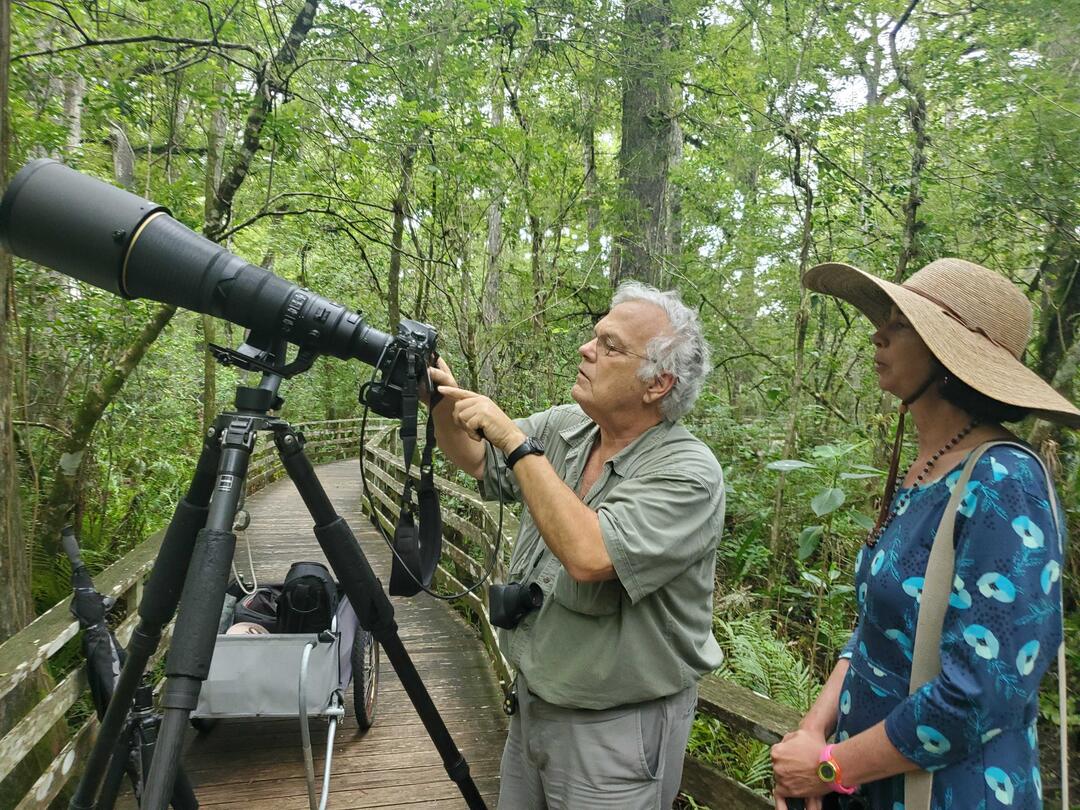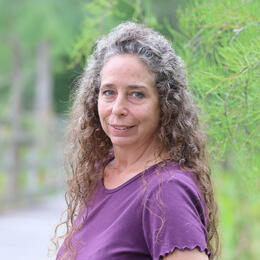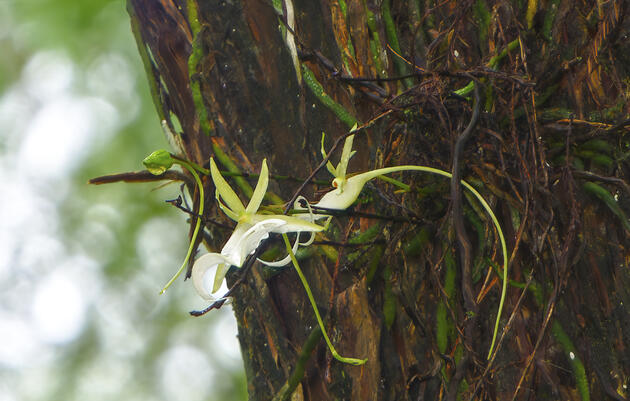Thunder rumbles in the distance as a bead of sweat rolls down his cheek. Glancing at his watch, RJ Wiley knows his window is closing, but he keeps his focus. It is late on a July afternoon and despite the stifling heat, he is determined to get the shot.
Nearly every summer, Wiley artistically captures imagery of an unusual orchid that only grows in swamps in southwest Florida and Cuba. Ghost orchids (Dendrophylax lindenii) cling to the bark of bald cypresses and pond apple trees, usually surrounded by clear, deep waters. Called “ghost” because it is leafless, this orchid is difficult to spot throughout much of the year. When its blossoms unfurl, they seem to float, untethered, with drooping tendrils outstretched like arms. Like tiny ghosts.
Audubon’s Corkscrew Swamp Sanctuary is one special place where ghost orchids thrive. In 2007, Audubon volunteers looking for owls spotted a large specimen about 50 feet high in an old-growth bald cypress tree, about 100 feet away from the boardwalk. Now known as the “Super” ghost orchid, it has attracted photographers and orchid enthusiasts from around the world, having produced as many as 40 blossoms in a single season.
Over the past 100 years, Florida has lost roughly 60 percent of its wetland hardwood forests, and the few that remain are isolated. Ghost orchids bloom in summer, typically from June through August, triggered by the seasonal onset of summer rains that fill the swamps and make them difficult to access.
Unlike birds or insects, ghost orchids do not move around and would seem easy enough to photograph. Wiley’s amazing imagery makes it look easy, but there is much more to it than just snapping a photo.
Surrounded by water and guarded by an army of mosquitoes, ghost orchids are elusive. Lightning and torrential rain can discourage would-be photographers from getting their shot, and Wiley has encountered his share of storms. But even light rain can spell trouble for the ghost-orchid photographer: the blossoms are so delicate that they bounce with each raindrop or puff of breeze.
Wiley has spent much time on the boardwalk, waiting for the light to be just right to illuminate the “Super” ghost orchid in its dark corner of the swamp. The orchid’s host tree, located about 100 feet off the boardwalk faces west, making afternoon the most likely time for good light. But, like how clouds can obscure the sun, the adjacent tree canopy can also sometimes block the light.
While the boardwalk provides a dry substrate on which to set his tripod, it is anything but solid – people walking on it within a few hundred feet can cause discernable camera shake. Wiley’s captivating shots require tremendous patience and perseverance: the process is a delicate balance between art and science.
Raised in Pompano Beach, Wiley moved to Bonita Springs in 1983. In the early 1990s, Wiley started putting more effort into photography. He visited the Sanctuary for the first time during a drydown and realized his potential.
“The place was packed with birds and I was hooked,” Wiley says. His favorite photo from the Sanctuary? A Great Egret in full mating plumage; he called it “A Wedding in the Swamp.”
Although Wiley has been the Sanctuary’s official photographer for more than a decade, he still enjoys loading up his van and hitting the road for a week or so during nesting season, sleeping at truck stops, and getting to the nests before sunrise. He also enjoys the special privilege of being the only photographer whose imagery is consistently available for purchase in the onsite Nature Store. Sanctuary visitors love bringing something home to commemorate seeing the ghost orchid, and sale proceeds help support Audubon’s mission.
Wiley, a longtime Friends of Corkscrew Swamp Sanctuary member, visits many times a year in his effort to capture each bloom put forth by the “Super” ghost orchid. He uses a Nikon D850 with 600mm lens and a 2x multiplier: by removing a tab from a 1.4 teleconverter and adding the two different magnifiers, he is able to extend his lens length to 1680 mm for the up-close images we can appreciate. This year, he created a Fresnal lens that throws the flash beam far enough to reach the orchid with ample light. The orchid seldom stops moving and the flash freezes the blooms’ movement, allowing for a clean shot.
“After photographing this orchid for so many years, I’m finally getting happy with the photos,” said Wiley.
For the Sanctuary, the “Super” ghost orchid provides a unique draw because it is the only place where people can see a ghost orchid growing in its natural habitat without wading through a swamp. Because visitors need to use binoculars, a spotting scope, or a high-powered camera lens to appreciate its beauty in person, the orchid is protected from visitor impacts like spraying bug spray or the urge to reach out and touch it. In addition to poaching, threats to ghost orchids include loss and/or degradation of habitat and climate change.
Some 60 years ago, thoughtful people saved this forest. It is our legacy to ensure future generations can continue to experience this amazing ecosystem. As long as we continue to maintain the ecological integrity of the swamp, ghost orchids will thrive here and captivate people’s interest. At Corkscrew Swamp Sanctuary, Audubon works with a variety of partners to manage and conserve these 13,450 acres as a remnant of natural Florida, for the benefit of our watershed, our wildlife, and our community.










